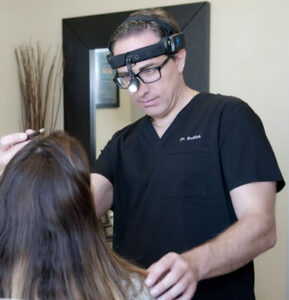Top ENT Procedures Explained: From Nasal Endoscopy to Balloon Sinuplasty

Dealing with ear, nose, and throat (ENT) issues can significantly impact your quality of life. From persistent sinus problems and breathing difficulties to recurring ear infections and sleep disturbances, these conditions often require specialized care. Understanding the available ENT procedures in Los Angeles, residents can access is the first step toward finding lasting relief.
Early diagnosis and targeted ENT treatments in LA are necessary for managing these conditions effectively. We’ll demystify some of the most common and effective ENT procedures, helping you feel informed and prepared should you need specialized care.
Nasal Endoscopy
One of the foundational diagnostic tools in an ENT’s arsenal is the nasal endoscopy.
- What it is: A nasal endoscopy is a minimally invasive, in-office procedure that uses a thin, flexible scope with a camera at its tip. This scope is gently inserted into the nasal passages, allowing your ENT specialist to visualize the nasal cavity, sinuses, and upper throat.
- What it diagnoses: This quick procedure is invaluable for diagnosing a range of conditions, including chronic sinusitis, nasal blockages, polyps, and even identifying the source of nosebleeds.
- The experience: The procedure is generally well-tolerated and typically causes no significant discomfort. There’s no downtime, meaning you can resume your regular activities immediately afterward. It provides your doctor with a detailed view that isn’t always available through external examination.
Balloon Sinuplasty
For those struggling with chronic sinus issues, balloon sinuplasty in Los Angeles offers a highly effective and minimally invasive solution. This procedure has revolutionized how chronic sinusitis is treated, providing an alternative to more invasive traditional sinus surgery.
- How it works: Balloon sinuplasty for sinus issues involves using a small, flexible balloon catheter. This catheter is guided into the blocked sinus passages and then gently inflated. The inflation widens the sinus opening, allowing for better drainage and ventilation. The balloon is then deflated and removed, leaving the sinus pathways open.
- The benefits: One of the key advantages of this top ENT procedure is that it’s typically performed in-office under local anesthesia. This means a quicker procedure and a significantly shorter recovery time compared to traditional surgery. Patients often experience long-lasting symptom relief, making it an excellent option for those seeking effective ENT treatment options in Los Angeles.
Also Read: Weather and Sinus Problems: What Triggers Symptoms and How to Manage Them
Septoplasty
A deviated nasal septum, where the wall between your nostrils is off-center, can lead to significant breathing difficulties. Septoplasty is the surgical solution for this common issue.
- What it corrects: Septoplasty focuses on correcting the deviated nasal septum, straightening it to improve airflow through both nostrils. This can dramatically reduce nasal congestion and make breathing easier, especially during sleep or physical activity.
- The procedure: It can be performed under general or local anesthesia, depending on the extent of the deviation and your surgeon’s recommendation. Often, septoplasty is combined with other procedures, such as turbinate reduction, to optimize breathing improvements.
Turbinate Reduction
Enlarged turbinates—structures within your nose that warm and humidify air—can also contribute to nasal obstruction. Turbinate reduction aims to reduce their size.
- How it’s done: This procedure can be performed using various techniques, including radiofrequency ablation, submucosal resection, or laser techniques. The goal is to shrink the turbinates while preserving their essential function.
- In conjunction with other procedures: Turbinate reduction is frequently done in conjunction with septoplasty to provide comprehensive relief from nasal congestion and improve overall nasal breathing.
Tonsillectomy & Adenoidectomy
While commonly associated with childhood, the removal of chronically infected or enlarged tonsils and/or adenoids (tonsillectomy & adenoidectomy) is also performed in adults.
- When it’s recommended: This procedure is typically recommended for recurrent throat infections, chronic tonsillitis, or, in adults, for addressing sleep apnea or other breathing issues caused by enlarged tissues.
- The procedure and recovery: Both procedures require general anesthesia. Recovery times can vary significantly based on age, with children often recovering more quickly than adults.
Tympanoplasty (Eardrum Repair)
A perforated eardrum can lead to hearing loss and increase the risk of ear infections. Tympanoplasty is the surgical repair of this delicate structure.
- What it treats: This procedure is often used to treat chronic ear infections that have led to eardrum damage or to repair perforations caused by trauma.
- The outcome: Successful tympanoplasty can restore the integrity of the eardrum, improve hearing, and prevent future infections. It’s typically performed as an outpatient surgery with a moderate recovery period.
Ear Tube Placement (Myringotomy)
Myringotomy, or ear tube placement, is one of the most common ENT procedures in Los Angeles specialists perform, particularly in children.
- What it involves: Small tubes are inserted into the eardrum to drain fluid from the middle ear and prevent recurring ear infections.
- Who benefits: This quick procedure, often done under general anesthesia, is most common in children with chronic recurring ear infections or persistent fluid buildup that can affect hearing and speech development. The tubes typically fall out on their own after several months, or they can be removed by a doctor.
Also Read: Understanding Tinnitus: Causes, Treatments, and When to See an ENT
Endoscopic Sinus Surgery

When less invasive treatments aren’t enough, endoscopic sinus surgery offers an advanced solution for severe or persistent sinusitis.
- How it’s performed: This sophisticated surgical technique utilizes a small camera (endoscope) and specialized instruments to meticulously remove blockages and diseased tissue from the sinus cavities.
- When it’s needed: It’s ideal for patients whose sinusitis doesn’t respond to medication or more conservative treatments. The procedure is typically performed under general anesthesia.
Nasal Polyp Surgery
Nasal polyps are noncancerous growths that can significantly obstruct breathing and contribute to chronic sinus infections.
- The surgical approach: Their removal is usually performed via endoscopic sinus surgery. This allows for precise and thorough removal of the polyps.
- Post-operative care: Follow-up care is often important to prevent recurrence, and may include steroid sprays or biologic therapy to manage inflammation and inhibit polyp growth.
Nasal Snoring and Airway Treatment
Snoring and sleep apnea can be more than just annoying; they can significantly impact health and quality of life. ENT specialists evaluate nasal obstruction as a primary contributor to these issues.
- Treatment options: Treatments may include procedures like septoplasty, turbinate reduction, or radiofrequency procedures to open up the nasal passages.
- Potential benefits: By improving nasal airflow, these procedures can often reduce the severity of snoring and, in some cases, even reduce dependence on CPAP machines for those with sleep apnea.
When to Consider ENT Procedures
Knowing when to seek an ENT specialist’s expertise is vital. Consider exploring ENT treatment options in Los Angeles if you experience:
- Chronic sinus infections: Frequent, persistent, or severe sinus infections that don’t respond to antibiotics.
- Difficulty breathing through the nose: Chronic nasal congestion or blockages affecting your ability to breathe comfortably.
- Sleep-disordered breathing: Persistent snoring, gasping for air during sleep, or a diagnosis of sleep apnea.
- Frequent ear infections or hearing issues: Recurring ear pain, fluid buildup, or a noticeable decline in hearing.
- Voice or swallowing difficulties: Persistent hoarseness, difficulty swallowing, or changes in your voice quality.
Also Read: How ENT Care Improves Breathing, Hearing & Speaking in Daily Life
FAQs
How do I know if I need an ENT procedure?
If you’re experiencing chronic or severe ear, nose, or throat symptoms that are impacting your daily life and haven’t responded to conservative treatments, it’s time to consult with an ENT specialist. They can conduct a thorough examination and recommend the best course of action.
Is balloon sinuplasty painful or invasive?
Balloon sinuplasty for sinus issues is considered minimally invasive and is typically performed with local anesthesia, making it much less painful and less disruptive than traditional sinus surgery. Most patients experience minimal discomfort during and after the procedure.
What’s the difference between a nasal endoscopy and a CT scan?
A nasal endoscopy provides a direct, visual examination of the nasal passages and sinus openings in real-time, allowing the doctor to see the surface and immediate structures. A CT scan, on the other hand, provides detailed cross-sectional images of the bones and soft tissues, offering a comprehensive view of the entire sinus anatomy, including deeper structures and potential blockages not visible with an endoscope. They are often used complementarily.
How long is recovery after septoplasty or turbinate reduction?
Recovery times vary, but most patients can return to light activities within a few days to a week after septoplasty or turbinate reduction. Full recovery and the complete benefit from improved breathing may take several weeks as swelling subsides.
Are tonsillectomies still recommended for adults?
Yes, tonsillectomies are still recommended for adults, particularly for cases of chronic tonsillitis, recurrent strep throat infections, or when enlarged tonsils contribute to sleep apnea or significant breathing problems.
Will I be awake during my ENT procedure?
Whether you’re awake depends on the procedure. Minimally invasive procedures like nasal endoscopy and balloon sinuplasty in Los Angeles are often performed in-office with local anesthesia, meaning you’ll be awake but comfortable. More complex surgeries, such as septoplasty, tonsillectomy, or endoscopic sinus surgery, typically require general anesthesia, so you will be asleep.
How long do ear tubes last, and do they fall out on their own?
Most ear tubes stay in place for 6 to 18 months and then fall out on their own as the eardrum heals and pushes them out. In some cases, a doctor may need to remove them.
Can ENT procedures improve my sleep or stop snoring?
Many ENT procedures, especially those addressing nasal obstruction like septoplasty and turbinate reduction, or those addressing enlarged tonsils/adenoids, can significantly improve breathing during sleep, thereby reducing snoring and alleviating symptoms of sleep apnea.
What should I avoid after an ENT surgery?
Specific post-operative instructions will be provided by your surgeon, but common recommendations include avoiding strenuous activity, blowing your nose forcefully, heavy lifting, and sometimes certain foods, especially after throat surgeries.
How do I choose the right ENT specialist for my needs?
When seeking ENT treatment options in Los Angeles, look for a board-certified ENT specialist with experience in the specific procedures you may need. Consider their reputation, patient reviews, and ensure they have a comprehensive understanding of top ENT procedures and a patient-centered approach to care. Check out Southern California ENT and Allergy Associates for more info!
